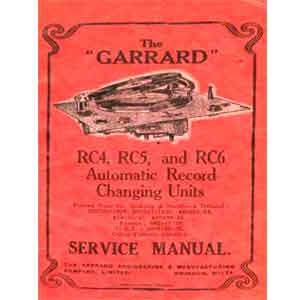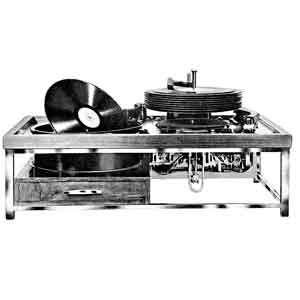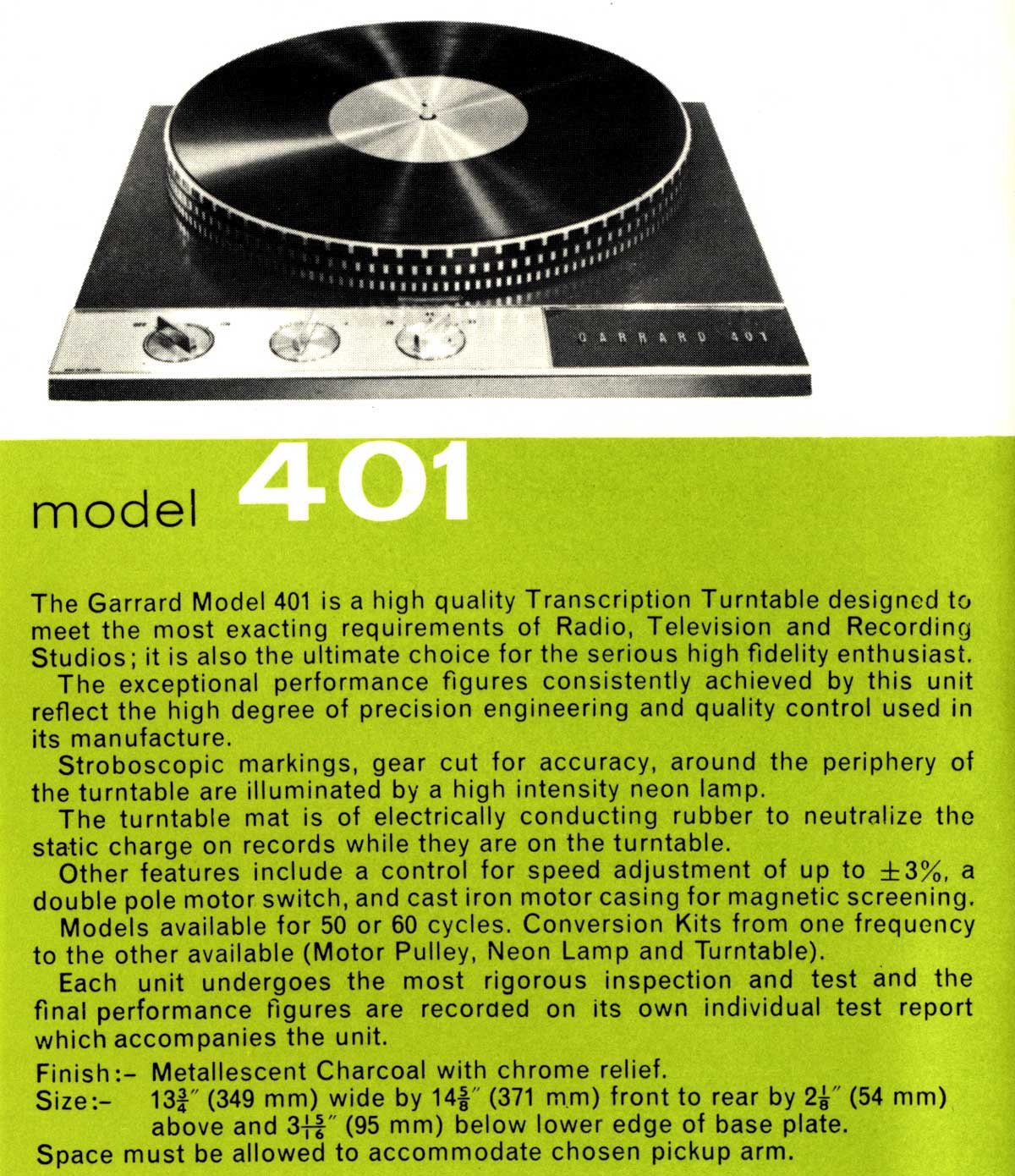Garrard Engineering and Manufacturing Company Ltd
GARRARD HISTORY
Garrard & Co. Limited, designs and manufactures luxury jewellery and silver. George Wickes founded Garrard in London in 1735. Garrard was the first official Crown Jeweller of the UK, charged with the upkeep of the British Crown Jewels, from 1843 to 2007. Garrard also created some of the world's most illustrious sporting trophies, including the Americas Cup, the ICC Cricket World Cup Trophy and a number of trophies for Royal Ascot.
In 1915, Garrard & Co formed, The Garrard Engineering and Manufacturing Company, to manufacture precision parts for the military. They initially made precision range finders and later hand-grenades marked 'G/Swindon' and the bomb releases for Wellington and Lancaster bombers.
After WW1, in 1919, they started producing consumer products, concentrating mainly on high-quality spring wound gramophone motors for the likes of Columbia and Decca. Before this all gramophone motors were imported in from Switzerland and Germany. During this time they designed and produced some of the very best spring & electric motors followed by a huge lineage of turntables which culminated with the now world famous Garrard 301 and 401 turntables.
In 1960, the company was sold to Plessey, an electronics conglomerate. From 1976-1978, Garrard worked on video disc and data storage but foolishly chose not to invest in the technology. In 1979, Plessey sold Garrard to Gradiente Electronics of Brazil and their turntable series production was moved to Brazil (Manaus). The remaining Garrard research and development operation in Swindon was reduced to a skeleton operation until completely shut down in 1992.
“Between 1992 and 1997, the Garrard brand name was licensed to other companies in the USA, which imported many electronic items built by many different and unrelated Far Eastern manufacturers. These included "Garrard"-branded cassette decks, CD players, stereo receivers, boom-box radio/cassette machines, portable "Walkman" type cassette players, serial-port printer cables, universal TV/audio remote controls, and other miscellany, including turntables that had nothing to do with any original Garrard design.”
In 1997, Gradiente licensed the Garrard name to Terence O'Sullivan, who operated as Loricraft Audio. A labour of love ensued. Terry O'Sullivan kept the Garrard legend alive. Laricraft Audio serviced and re-built the classic Garrard 301's and 401's and also manufactured support products. They became the leading authority on 301's and 401's
In 2006 Loricraft continued the Garrard legacy by introducing the next generation of classic Garrard Turntables. The Garrard 501 and soon followed by the Garrard 601. They were designed with guidance from a number of former Garrard employees. “Among them was Brian Mortimer, head of quality control at the Swindon factory. And Brian's father, the late Edmund (Monty) Mortimer, was the head of research at Garrard so this creates an unbroken link with pre-Gradiente, pukka Garrard.” The Mortimer’ have written a wonderful book on the subject, “The Garrard Story”
In 2018, Cadence Audio SA, who also own the British turntable and tonearm manufacturer SME Limited, took ownership of the Garrard brand and registered trademarks when they purchased Loricraft Audio Ltd. The business was restructured to run under the name of Garrard Turntables UK Ltd. What will they produce next?
GARRARD TIMELINE
- 1721: Garrard and Company was appointed Crown Jewellers of London.
- 1914: Garrard & Co manufactured precision range finders for the British Artillery.
- 1915: They formed the Garrard Engineering and Manufacturing Company Ltd with Major S. H. Garrard as Chairman to produce precision range finders. Factory setup at White Heather Laundry in Willesden, London.
- 1918: At the end of the WW1, Garrard decided to diversify and manufacture consumer products. To manage this side of the business they employed a Mr Herbert Vaughan Slade (known as HV). They started the production of small lathes and boring tools and found their calling in the need for quality spring wound motors for the fast developing gramophone industry.
- 1919: The White Heather Laundry requested its premises back, and so the company moved to Swindon where there were plenty of skilled engineering apprentices from the Great Western Railway Company. The company was now headed by H.V. Slade, who was about to play a major role in the development at the Swindon factory. The Garrard 1 double spring motor was introduced. The company’s workforce was a meagre 38 employees but hopes were high for expansion, even against the backdrop of high unemployment caused by soldiers returning from the Western Front. At the British Industries Fair they were billed as; Manufacturers of Highest-class Gramophone Single and Double Spring Motors, Pressed Steel Turntables, Brakes, Winding Cranks, etc. There was talk of the firm bringing 500 jobs, it turned out to be a gross under-estimate in the long-term.
- 1920-28: Other products produced at this time included motors for Primus construction kits (The earliest serious rival to Meccano in the field of toy construction sets was Primus), a cine-camera/projector (Campro), and a device for playing records at a constant linear speed which almost doubled the playing time (The World Record Controller).
- 1925: Eleven types of spring-driven motors were being made at a rate of 350,000 a year.
- 1926: Garrard became a public company to finance the expansion needed to meet the demand for spring motors.
- 1928: Garrard employed an electrical engineer, Stuart Philpott. Philpott along with an assistant, Edmund Walter Mortimer were given the task of designing an electrically driven gramophone motor. Development started on electrical motors, which in 1929, resulted in a belt drive motor. Model E. It could be used with AC and DC and requires 40 to 50 volts. AC frequency 25 or 60 Hz and 100 to 250 Volts.
- 1930: The motor development programme led to the first Garrard gramophone. Previously they had only produced motors for its customers. They also decided to make a super quality alternating current gramophone motor as a prestige model. It was taken up by the BBC and other broadcasters, cinemas, and it became very popular with HiFi enthusiasts. It was originally just for 78rpm records, but was later modified to play the 33⅓ rpm, 16 inch records used in cinemas. It was the first of what were later to be called transcription turntables. The Garrard 201.
- 1931: A subsidiary company, Garrard Clock, was set up to manufacture and sell clocks using spring motors produced by the parent company.
- 1932: The first Garrard record changer was developed by Mr E.W. Mortimer. The R.C.1a and R.C.2a. The development of radio tuners and amplifiers meant that electronic pickups could replace the old acoustic horn systems. This led to a big increase in the sales of radiograms, and record players. Garrard produced some arms and pickups for its turntables. Finally, to replace the spring motor, they had to produce motors that were relatively cheaper than the Transcription Garrard 201. They came up with Models, 202A, A.C.4 and the A.C.6 which became the most popular model produced by Garrard and used by the majority of radio-gramophone manufacturers.
- 1936: Exports start to America, Sweden and Canada amongst others. Overseas agents appointed.
- 1937: The Garrard shop display turntable GDT3 introduced.
- 1938: The RC100 record changer, which could play both sides of each record, and also mixtures of 10 and 12 inch records, was produced for sale in the USA. In late 1939, the ship carrying the first batch of 100 of these was torpedoed and sunk in mid Atlantic.
- 1939-45: Production ceased during WW2. The Ministry of Defence made full use of the Garrard factory. Large numbers of clock-based mechanisms were made for mines, parts for Radar, aircraft bomb release mechanisms, range finders, machining of hand grenade bodies and record players for the troops. The Garrard 201 & 201b. Employees during war period 1,200.
- 1945: Following the death of Major S. H. Garrard, H.V. Slade cut all links with Garrard and Company, the Crown Jewellers and The Garrard Engineering and Manufacturing Company Ltd became a separate entity.
- 1946: Competition was fierce and a new record changer had to be rapidly developed. The RC60 was introduced. It, and similar models, were produced around the clock as demand escalated. It was the last model to play only 78rpm records.
- 1947: H.V. Slade remained a chairman but his son Hector Slade took over as managing director. Listed Exhibitor - British Industries Fair. Manufacturers of Automatic Record Changers, Radio Gram Units, Gramophone Motors, Spring Gramophone Motors, Pick-up Magnetic, Crystal and High Fidelity.
- 1948: The Model RC70 record changer was introduced to play the new 10 and 12 inch, 33⅓ rpm and 7 inch 45rpm vinyl records, as well as the older 78rpm records. It was the forerunner of the RC80 in 1950, which sold for many years. Large numbers were sold in the USA. New lightweight pickups and arms were developed for these records, and the RC80 was the first with a magnetic cartridge.
- 1950: Exports, mostly to the USA rose to 50 per cent and kept rising, and H.V. Slade received the CBE in 1950 in recognition of the firm's contribution to Britain's never-had-it-so-good economy.
- 1954: A Garrard turntable was launched for the serious HiFi market. It has become one of the icons of design and performance. The classic Garrard 301. Clock making was stopped due to cut-price competition.
- 1957: Garrard released one of the first stereo pickups when stereophonic records were introduced.
- 1958: A serious factory fire occurred on March 21, 1958, but production was restored with the help of a neighbouring company, Plessey, which loaned factory space. A further small factory in Blunsdon was acquired to produce component parts.
- 1959: The new Autoslim series was launched with help from Plessey.
- 1960: Garrard became part of the Plessey group of companies with the name Garrard Engineering Ltd. Another factory was acquired in Swindon. There was also a factory in Wigan which exported to the USA via Liverpool.
- 1961: Herbert Vaughan Slade died and Garrard's fortunes changed. Plessey moved in and a lot of the senior staff were dismissed and replaced by the Plessey faithful. (I previously stated "Hector & Ken Slade were dismissed with a golden handshake"). Correction by the grandson of Mr H.V. Slade, Christopher J V Slade "My father was Kenneth Slade and he continued working for Plessey until 1978. He retired at this point and died of pancreatic cancer in June 1989. My uncle, Hector, stayed on for approximately a year before emigrating to Australia".
In 1961, Garrard also developed a novel Magazine Tape Deck, but it failed as it was more cumbersome than the Philips Compact Cassette launched in 1963.
- 1964: The Model Lab 80 was launched as the first record changer which had the performance of a transcription turntable. It had many unique adjustment features including a wooden arm. The Garrard 401 was introduced to replace the Garrard 301.
- 1965: Garrard SP25 introduced, It had four speeds; 16, 33⅓, 45 and 78RPM. The SP25 was probably the most popular model Garrard ever produced. All the SP25s from the first to the fourth (which surfaced in 1974) were largely the same. The mk1 and mk2 were semi-automatic designs, whereas from the mk3, fully automatic operation was standard.
- 1966: Garrard received the Queen's Award for Industry in 1966 and 1970 and in 1973.
- 1971: The Zero 100 automatic transcription table was introduced with its revolutionary tangential tracking arm. Garrard received a series of awards for its development - The Queens Award, The Italian Mercurio d'Oro Award, and the USA's Emile Berliner Award.
- 1973: 4000 employees
- 1975-1976: Garrard's first direct drive player began production. Garrard DD-75. These stayed in production with design changes until 1979.
- During the 1970s Garrard fell on hard times when under the Plessey banner failed to respond to the rising challenge of the Japanese hi-fi industry. The result was the demise of a company that at one time employed over 4000 people to a position of £3 million losses a year and a workforce of 400.
- 1979 November: Garrard was sold to Gradiente Electronica of Brazil for £1 million, partly to protect a maker record player chassis supplier to its Brazilian factories but more importantly to provide a respected European brand name which it could use as a launching pad to break into eastern markets - it already had 80% of the South American hi-fi markets.
- 1981 June: Garrard pitched itself back into the Hi-Fi business with the slogan "The Empire strikes back" and the launch of the completely new range of equipment aimed at challenging the Japanese stereo industry. Alan Kirton was managing director.
- 1992 The company closed. The Garrard brand name was licensed to other companies in the USA, which imported many electronic items built by many different and unrelated Far Eastern manufacturers. These included "Garrard"-branded cassette decks, CD players, stereo receivers, boom-box radio/cassette machines, portable "Walkman" type cassette players, serial-port printer cables, universal TV/audio remote controls, and other miscellany, including turntables that had nothing to do with any original Garrard design.
- 1997: Gradiente licensed the Garrard name to Terence O'Sullivan, who operated as Loricraft Audio. Laricraft serviced and re-built the classic Garrard 301’s and 401’s and also manufactured support products. They became the leading authority on 301's and 401's.
- 2006: Loricraft continued the Garrard legacy by introducing the next generation of classic Garrard Turntables. The Garrard 501 and soon followed by the Garrard 601.
- 2018: Cadence Audio SA, who also own the British turntable and tonearm manufacturer SME Limited, took ownership of the Garrard brand and registered trademarks when they purchased Loricraft Audio Ltd. The business was restructured to run under the name of Garrard Turntables UK Ltd. What will they produce next?
In 1961, Garrard also developed a novel Magazine Tape Deck, but it failed as it was more cumbersome than the Philips Compact Cassette launched in 1963.
GARRARD MOTORS
This section will try and document Garrard motors during the golden age of the Gramophone. It covers all spring motors and attempts to cover electrical motors up to the Garrard 401 transcription turntable. It does not cover the myriad of players and record changers produced by the company.
Motors made by Garrard for other companies, like Columbia, Decca, HMV, Selecta and many others., were often marked with that companies name.
Here is a quick reference page for Garrard Spring Motors.
Set models were often improved and then marked as type A and Type B. Here for example is a Garrard model 10. It has three different improvements.

- Garrard 10 - Note that the winder is positioned in the middle of the motor.
- Garrard 10a - The winder has moved to the top of the motor. The larger winder gear has been moved from the bottom to the top. To position the gear, a section is now cut out of the cast allowing room for the gear.
- Garrard 10b - As for 10a plus added side mounted governor adjustment for an above motorboard lever control. Also improved Garrard patented governor with weights screwed onto the inside of the governor spring.
Garrard Main Springs
This snippet from an undated catalogue suggests that each one of these Garrard motor models had unique spring sizes
*The Pressed steel turntable patent GB216823 was granted to Garrard on June 5th 1924. It had a bevelled hollow rim. This enable the fraying edge of the plush that the turntable was covered with to be tucked in. Plush unlike felt is a woven material which is prone to fraying at the edge when cut but was also available in a large variety of colours.
GARRARD LEGENDS
This section covers the two Transcription Turntables made by Garrard that today are considered "Legends". The Garrard 301 and the Garrard 401.
Transcription Turntables are assessed by measuring the amount of rumble and wow & flutter generated by the turntable while playing a record. No turntable is perfect, there is always a degree of noise created by accuracy of speed and its stability, friction, heat and electrical interference from the electric motor. The wow & flutter may be too tiny to hear but can be recorded when amplified with test equipment and are recorded as a degree. It’s measured as RMS (root mean square) values at 33⅓ rpm, of the sine wave voltage on test equipment.
To qualify as a Transcription Turntable, the following criteria is applied.
- Wow: (Variations in turntable speed below 20Hz) Better than 0.1% RMS
- Flutter: (Variations in turntable speed above 20Hz) Better than 0.04% RMS
- Rumble: (Unwanted background noise below 500Hz, only really significant below 200Hz) Better than -32dB relative to 1kHz at a recorded velocity of 1cm/sec
Transcription Turntables are used by audio enthusiasts, radio, television and recording studios. They are built to a higher standard of precision engineering than commercial record players. They also needed to be robust as often they were used 24/7.
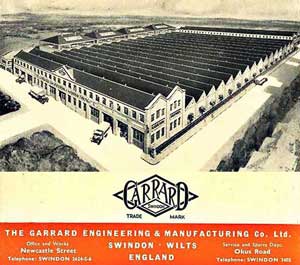
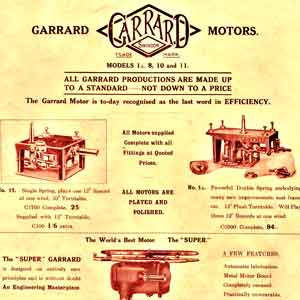
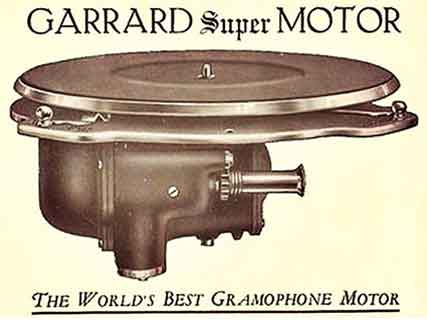
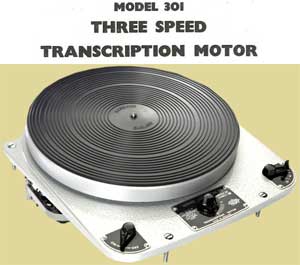


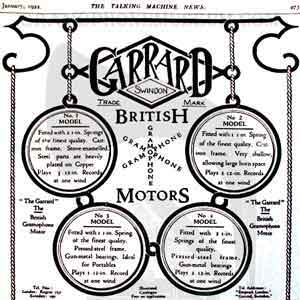

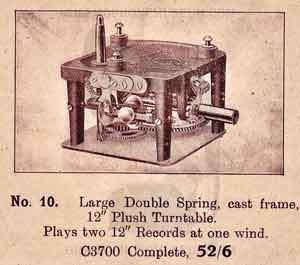


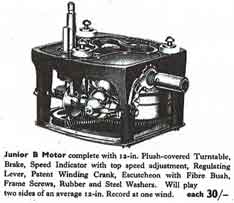
.jpg)
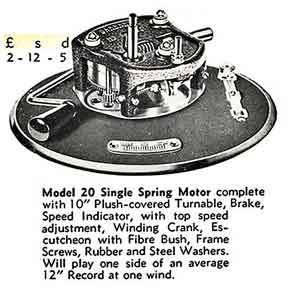



.jpg) The First Garrard Electric Motors
The First Garrard Electric Motors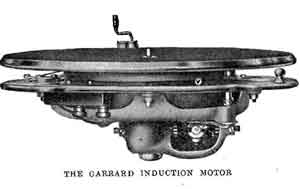 The first Transcription Turntable
The first Transcription Turntable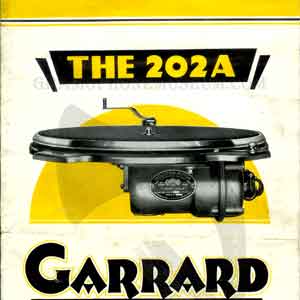
.jpg)
 Garrard's most popular motor
Garrard's most popular motor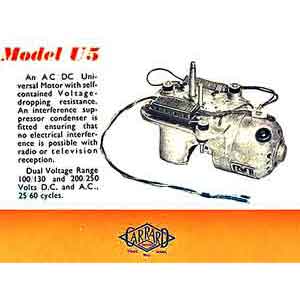 Garrard Universal AC/DC motor
Garrard Universal AC/DC motor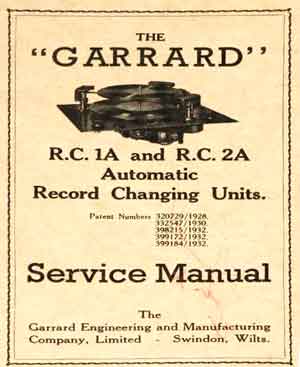 First Garrard Record Changer
First Garrard Record Changer